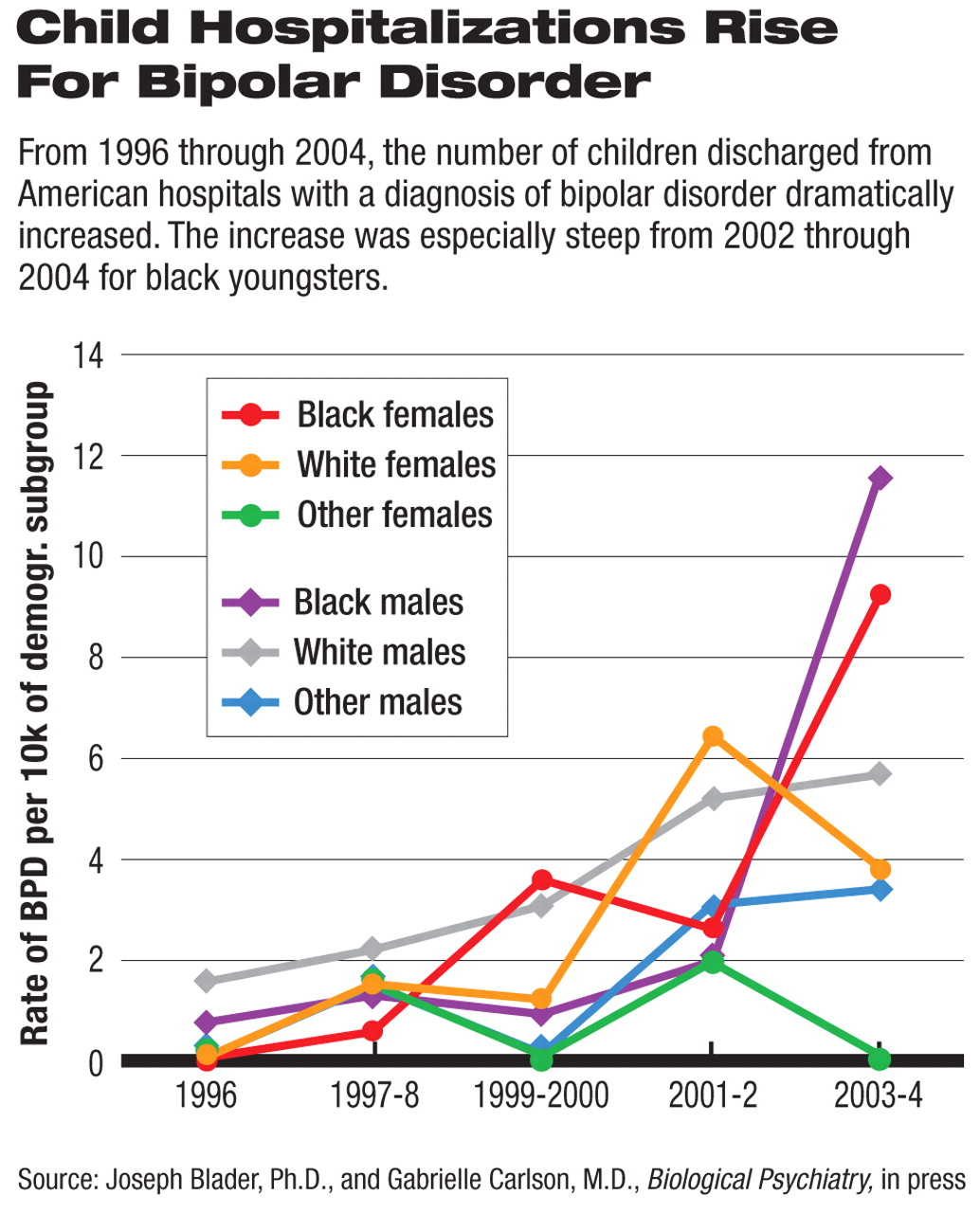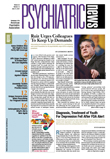Joseph Blader, Ph.D., an assistant professor of psychiatry, and Gabrielle Carlson, M.D., a professor of psychiatry at the State University of New York at Stony Brook, studied the rates of hospital discharges in the United States from 1996 through 2004.
Some interesting findings emerged with regard to bipolar disorder among children (aged 5 to 13) and adolescents (aged 14 to 18).
The number of bipolar disorder discharges increased fivefold in children—from 1.3 to 7.3 per 10,000 of the general population—and fourfold in adolescents—from 5.1 to 20.4 per 10,000 of the general population.
As a proportion of the total number of psychiatrically related discharges, children diagnosed with bipolar disorder constituted 10 percent in 1996 and 40 percent by 2004.
Moreover, bipolar disorder was one of the least-frequent psychiatric diagnoses recorded for child inpatients in 1996, but the most common in 2004. And while there were twice as many discharges of adolescents in 1996 for a depressive disorder than for a bipolar one, by 2004 the rates were about equal.
The findings are in press with Biological Psychiatry.
When Psychiatric News asked Kiki Chang, M.D., director of the Pediatric Bipolar Disorders Program at Stanford University, what he thought of these findings, he was astounded. The findings, he continued, are even more remarkable “when one considers that, at least in the San Francisco Bay area, inpatient beds have decreased during that time, and thresholds for admissions have been raised.”
To which David Axelson, M.D., an assistant professor of psychiatry at the University of Pittsburgh and a pediatric bipolar authority, added, “The authors have clearly identified a remarkable increase in the proportion of hospitalized children and adolescents assigned a bipolar disorder diagnosis at discharge.”
The reasons for this dramatic increase, however, are open to speculation at this point. It might reflect an “upcoding” of volatile, aggressive behavior in children with bipolar disorder to obtain reimbursement from managed care, Blader and Carlson proposed in their study report. “The survey years considered in this report coincided with payers' efforts to constrain the use of costly inpatient services.”
Or it might mirror an increased recognition of pediatric bipolar disorder, Chang and Axelson suggested. “I think we have gotten better at identifying bipolar disorder in kids since 1996,” Axelson said. “A bipolar diagnosis of 40 percent of child [psychiatric] admissions in 2004 does seem high, but I also think the [actual] rate is significantly more than the 10 percent rate [found] in 1996.”
In contrast, Axelson conjectured, the upswing in bipolar discharges among youth during the period could be due to higher rates of hospital readmission.“ During the study interval,” he explained, “the admission criteria for hospitalizing children and adolescents became substantially more stringent. The length of hospital stays dropped, and readmission rates increased. Since kids with bipolar disorder have high rates of dangerous behavior, aggression, psychosis, and suicidality, I would expect that they would be proportionally more likely to meet the more stringent admission criteria and need readmission more often than [youth with] other diagnoses.”

Race may have also played a role in the upswing, Blader and Carlson suggested. Demographic differences in bipolar diagnoses in the earlier survey years showed lower rates of the diagnosis among black youth, and especially among black boys, than among youth of other races. However, in the most recent survey years —2002 to 2004—bipolar discharges among black children increased markedly for both boys and girls and came to exceed the rates among white boys and girls. “It would be a positive development if this trend corrects a bias that led to misdiagnosis in the past,” Blader and Carlson said.
None of these bipolar authorities, though, seems to believe that the upswing in bipolar discharges among youth is due to an increase in incidence of the illness among them. However, Chang did venture that it might reflect an“ increase in the severity of childhood presentations of bipolar disorder.”
The new study was based on data provided by the National Hospital Discharge Survey, which the National Center for Health Statistics conducts annually. It captures patient-level information pertaining to discharges during the calendar year from nonfederal general hospitals, children's hospitals, and more specialized hospitals.
The study was funded by the National Institute of Mental Health and the National Alliance for Research on Schizophrenia and Depression.
An abstract of “Increased Rates of Bipolar Disorder Diagnoses Among U.S. Child, Adolescent, and Adult Inpatients, 1996-2004” is posted at<www.journals.elsevierhealth.com/periodicals/bps/article/PIIS0006322306014466/ab...>.▪

